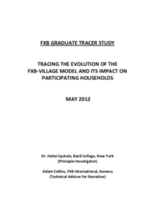Development experts agree that orphans and vulnerable children should remain in their communities whenever possible, but the global consensus is unclear on how best to support the families that care for them. For over 20 years, FXB International has refined its community-driven “FXB-Village” model into a structured program of household support and economic strengthening designed to empower particularly vulnerable families to escape extreme poverty and ensure the enduring wellbeing of the children in their care.
From their starting point at baseline as the poorest households in their communities, the FXB-Village participants in all three study areas are, on average, now faring at least as well as nearby households in most aspects of wellbeing. The dimensions measured include income, savings, nutrition, child health, water, sanitation, housing and education.
It follows that, as the capacities of the poorest households in the community are strengthened, there is an increased sense of dignity and prosperity among community members that transforms the wellbeing of the community as a whole. In the year 2010 alone, FXB-Villages directly served more than 42,000 children and their family members, and indirectly served over 115,000 neighbors and other community members.
In general, the communities in all three study areas are still extremely poor in 2011, with many households living close to the poverty line. However, there is a clear trend of increased financial stability across the three study areas, with each successive program showing an increase in savings and home ownership.
Country-specific differences were observed and recognized to be in line with national survey data. These include evidence of poor access to healthcare services in Uganda and higher levels of food insecurity in Rwanda.

